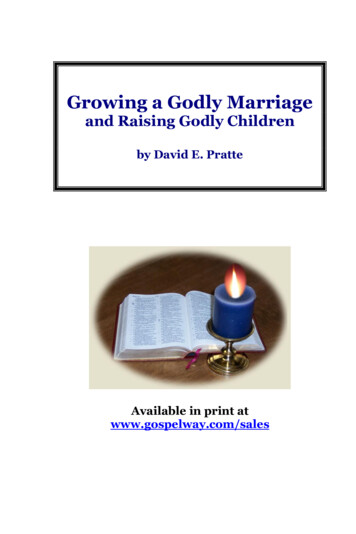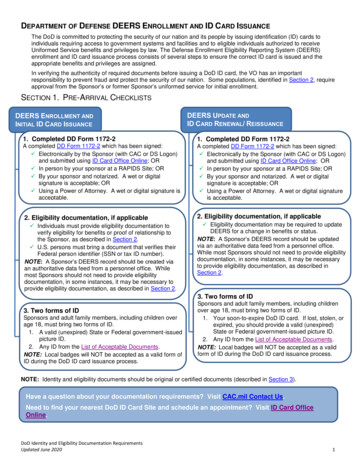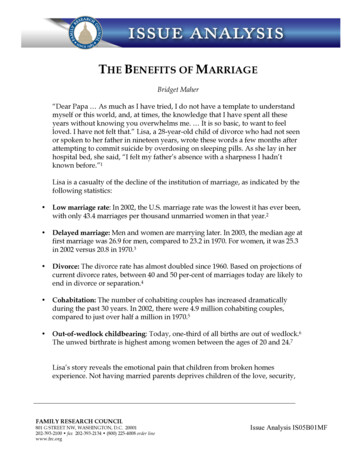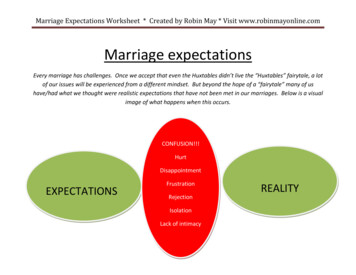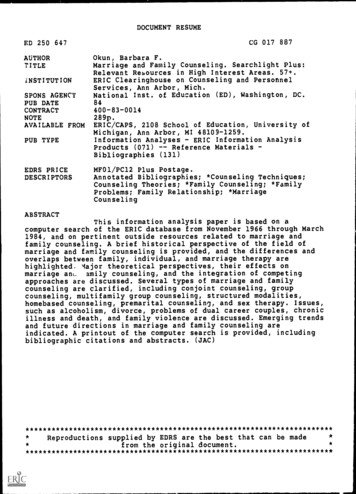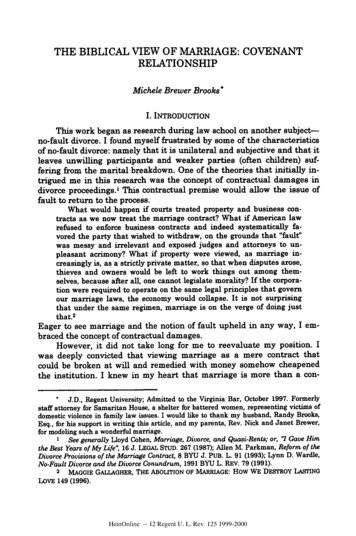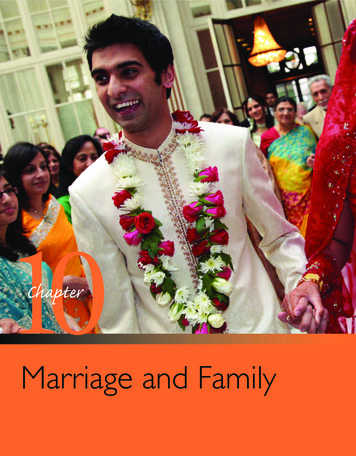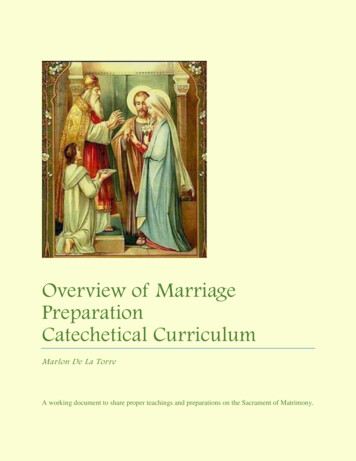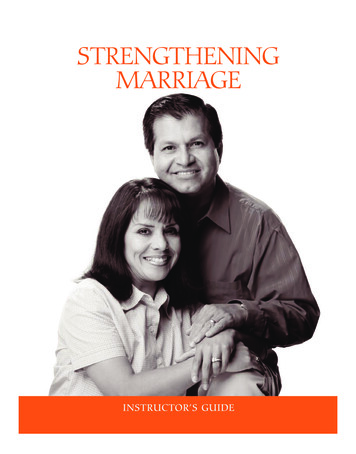
Transcription
36889 000 COVER.qxd06-23-20112:36 PMPage 1STRENGTHENINGMARRIAGEINSTRUCTOR’S GUIDE
36889 000 COVER.qxd06-23-20112:36 PMPage 2
36889 000 BODY2.qxd 08-23-2007 11:08 Page iSTRENGTHENINGMARRIAGEINSTRUCTOR’S GUIDEPublished byThe Church of Jesus Christ of Latter-day SaintsSalt Lake City, Utah
36889 000 BODY2.qxd 08-23-2007 11:08 Page iiTHE LORD HAS PROMISEDETERNAL FAMILY RELATIONSHIPS TOTHOSE WHO MAKE AND KEEPTEMPLE MARRIAGE COVENANTS.
36889 000 BODY2.qxd 08-23-2007 11:08 Page iiiCONTENTS“The Family: A Proclamation to the World” .ivGuidelines for the Instructor.v1. Applying Gospel Principles .12. Communicating with Love .113. Fostering Equality and Unity .234. Overcoming Anger .335. Resolving Conflict.476. Enriching Marriage.55Appendix .63IMAGE CREDITSPage xii (top): O Jerusalem by Greg K. Olsen. Greg K. Olsen. Do not copy.Page 46 (top): The Sermon on the Mount by Carl Heinrich Bloch. Used by permission of the National Historic Museum at Frederiksborg inHillerød, Denmark. Do not copy.Except as noted below, all photography is by Robert Casey. Robert Casey. Do not copy.Page ii: Brian K. Kelly.Page xi: Steve Bunderson. Steve Bunderson. Do not copy.Page 8: Corbis.Page 12 (bottom): Welden C. Andersen.Page 46 (bottom): Craig W. Dimond. 2006 by Intellectual Reserve, Inc. All rights reserved. Printed in the United States of America. English approval: 8/02
36889 000 BODY2.qxd 08-23-2007 11:08 Page ivTHE FAMILYTHE FIRST PRESIDENCY AND COUNCIL OF THE TWELVE APOSTLESOF THE CHURCH OF JESUS CHRIST OF LATTER-DAY SAINTSWE, THE FIRST PRESIDENCY and the Council of theTwelve Apostles of The Church of Jesus Christ of Latterday Saints, solemnly proclaim that marriage between aman and a woman is ordained of God and that thefamily is central to the Creator’s plan for the eternaldestiny of His children.ALL HUMAN BEINGS—male and female—are created in theimage of God. Each is a beloved spirit son or daughter ofheavenly parents, and, as such, each has a divine natureand destiny. Gender is an essential characteristic of individual premortal, mortal, and eternal identity and purpose.IN THE PREMORTAL REALM, spirit sons and daughters knewand worshiped God as their Eternal Father and acceptedHis plan by which His children could obtain a physicalbody and gain earthly experience to progress toward perfection and ultimately realize his or her divine destiny asan heir of eternal life. The divine plan of happiness enablesfamily relationships to be perpetuated beyond the grave.Sacred ordinances and covenants available in holytemples make it possible for individuals to return to thepresence of God and for families to be united eternally.THE FIRST COMMANDMENT that God gave to Adam andEve pertained to their potential for parenthood as husband and wife. We declare that God’s commandment forHis children to multiply and replenish the earth remainsin force. We further declare that God has commandedthat the sacred powers of procreation are to be employed only between man and woman, lawfully weddedas husband and wife.WE DECLARE the means by which mortal life is created tobe divinely appointed. We affirm the sanctity of life and ofits importance in God’s eternal plan.HUSBAND AND WIFE have a solemn responsibility to loveand care for each other and for their children. “Childrenare an heritage of the Lord” (Psalms 127:3). Parents have asacred duty to rear their children in love and righteousness, to provide for their physical and spiritual needs, toteach them to love and serve one another, to observe thecommandments of God and to be law-abiding citizenswherever they live. Husbands and wives—mothers andfathers—will be held accountable before God for the discharge of these obligations.THE FAMILY is ordained of God. Marriage between manand woman is essential to His eternal plan. Children areentitled to birth within the bonds of matrimony, and to bereared by a father and a mother who honor marital vowswith complete fidelity. Happiness in family life is most likelyto be achieved when founded upon the teachings of theLord Jesus Christ. Successful marriages and families areestablished and maintained on principles of faith, prayer,repentance, forgiveness, respect, love, compassion, work,and wholesome recreational activities. By divine design,fathers are to preside over their families in love and righteousness and are responsible to provide the necessities oflife and protection for their families. Mothers are primarilyresponsible for the nurture of their children. In thesesacred responsibilities, fathers and mothers are obligatedto help one another as equal partners. Disability, death, orother circumstances may necessitate individual adaptation. Extended families should lend support when needed.WE WARNthat individuals who violate covenants ofchastity, who abuse spouse or offspring, or who fail tofulfill family responsibilities will one day stand accountable before God. Further, we warn that the disintegrationof the family will bring upon individuals, communities,and nations the calamities foretold by ancient andmodern prophets.WECALL UPON responsible citizens and officers ofgovernment everywhere to promote those measuresdesigned to maintain and strengthen the family as thefundamental unit of society.This proclamation was read by President Gordon B. Hinckley as part of his message at theGeneral Relief Society Meeting held September 23, 1995, in Salt Lake City, Utah.
36889 000 BODY2.qxd 08-23-2007 11:08 Page vGUIDELINESFOR THEINSTRUCTORStrengthening marriage is essential, especially in these latter days when confusion andtemptation abound. Speaking of our time, President Gordon B. Hinckley said: “Thefamily is falling apart all over the world. The old ties that bound together father andmother and children are breaking everywhere. . . . Hearts are broken; children weep.Can we not do better? Of course we can.”1This course was created in response to the need for stronger family relationshipsand was written to benefit as many people as possible. It contains gospel principlesand skills to help participants improve their marriages.Use this instructor’s guide in conjunction with the resource guide for couples. Itprovides supplemental information to help you conduct class sessions successfully.Several ideas in this introduction and in the appendix were adapted from the instructor’s guide of Principles of Parenting, a series written by H. Wallace Goddard andpublished by the Alabama Cooperative Extension Service. 2ADMINISTERING THE COURSEThe course should typically be taught to groups of 20 or fewer participants by professionals at LDS Family Services agencies or by volunteers in wards and stakes. Atypical course will last six to eight sessions. Sessions are usually 90 minutes in length.Strengthening Marriage: Resource Guide for Couples includes six topics that may beused in group meetings. Although you will select the topics that you think will bestaddress the needs of class members, you should teach session 1, “Applying GospelPrinciples,” as the first session of the course. To be addressed adequately, some topicsmay require two or more class sessions.Consider the following suggestions for administering the course: Follow agency guidelines for charging group fees when the course is sponsoredby an agency of LDS Family Services. When the course is sponsored by a stakeor ward, the fee should cover only the cost of materials. Participants shouldpay the fee at the beginning of the course to help encourage attendance. Encourage couples to attend sessions together to foster harmonious relationships.The principles they learn can draw them together when they both participate, butthese principles can become a wedge if one person is uninvolved or unsupportive. Keep track of the number of sessions attended by each participant by takingroll each time you meet (see page 66 in the appendix).v
36889 000 BODY2.qxd 08-23-2007 11:08 Page viGUIDELINES FOR THE INSTRUCTOR Contact the nearest LDS Family Services agency if you have questions aboutteaching the course. Agency locations and telephone numbers can be found atwww.ldsfamilyservices.org.ANNOUNCING THE COURSEWhen you share information about the course, describe what individuals and couplescan gain by attending. A list of benefits will more readily motivate couples than a listof topics to be discussed.The benefits of the course are many. Individuals who participate will learn howto resolve conflict, foster greater intimacy and trust, and make marriage a priority so they can enjoy greater happiness together. They will learn to listen and toshare sensitive and painful feelings and to handle angry feelings appropriately. Theywill gain a better appreciation for the eternal significance of the marriage covenantand of the eternal possibilities that come through celestial marriage. They will learnto develop greater unity, equality, and mutual respect.Consider using the information sheet on page 64 in the appendix to share information about the course.QUALIFICATIONS TO TEACH THIS COURSEThis course may be taught by any adult who is knowledgeable about relationshipskills and the challenges couples face in marriage. Some keys to teaching this courseeffectively include sensitivity to others, a knowledge of the gospel, and an understanding of the sanctity of marriage and an appreciation for it.The most important qualification for teaching this course is your personal preparation to receive the guidance of the Holy Ghost. The Lord said, “The Spirit shall begiven unto you by the prayer of faith; and if ye receive not the Spirit ye shall notteach” (D&C 42:14). Most people have had the experience of stumbling through alesson in which thoughts seem disconnected and the message is lost on a disinterestedaudience. Contrast those experiences with the times when the Spirit was present,when information and impressions came to mind, when words flowed more readilyand the Spirit communicated truth to the hearts and minds of others.EFFECTIVE TEACHINGYou will be most effective as a teacher as you seek inspiration and as you bring yourown knowledge, ideas, experiences, and personality to the class. When you teach bythe Spirit, you will help participants reflect on their own experiences and learn howto improve their marriages. Consider how you can use your experiences to teach andreinforce the principles and skills. Put your heart into your teaching, and you willfind great joy in your interaction with class members.The wealth of experience of each participant is a great asset to you as you teachthe course. Recognize the responsibility of each individual for his or her marriage,and share your knowledge and expertise as guided by the Spirit. You should understand that your responsibility is to open doors to new possibilities, not to dictate tocourse participants. Each class is a collaborative effort, with you and class memberssharing ideas and insights and offering support.vi
36889 000 BODY2.qxd 08-23-2007 11:08 Page viiGUIDELINES FOR THE INSTRUCTORAs you share your knowledge, experiences, and insights, encourage class membersto think about their own experiences and strengths. Help them identify principlesthat can help them improve, and encourage them as they develop skills to applythose principles. As you practice these same skills, you will grow in your ability asa teacher.Use the course manual as it is intended, seeking guidance from the Spirit in determining what to teach and how to teach. After prayerfully considering the principlesin this manual, organize your presentation by considering what individual classmembers need to learn about the subject you are teaching. Try asking yourself,“What do class members need to learn today?” You will likely come up with oneor two main ideas. Then consider what supporting ideas will help class membersunderstand the main ideas. Once you have identified a main idea and supportingideas, determine the best way to present them. The following teaching strategiesmay help you as you plan.Using Stories to Illustrate a PrincipleTo begin a session, you might write the main idea or principle on a chalkboard and thentell a story that illustrates it. Stories are effective because they can touch hearts andchange lives; they can illustrate abstract principles and make them easier tounderstand. Life is made up of stories, and people easily remember stories and theprinciples they teach.The Savior taught powerfully through the use of stories. Try to keep the stories youtell short and as simple as possible. Be careful not to tell too many personal stories.They may invade the privacy of your spouse and offend others as well.Class members will have difficulty relating to personal stories if your marriageseems too perfect. Too many of such stories may discourage class members in theirown efforts to change. If it seems appropriate, share some stories about challengesyou have faced and struggles you have had as well as stories about your successes.When you share these stories, explain what you have learned from those experiences.Be positive and explain what you have done to improve. If your stories disclose toomany problems, you may lose credibility and participants may get the idea that theprinciples you teach do not work.Role PlayingAfter you have taught class members how to apply a principle in marriage, youmight reinforce the principle through role play. The best role playing often occurswhen you start by saying, “What usually happens in this situation?” Have someoneact it out. The class can then discuss the mistakes couples often make in these situations. After some discussion, you might say: “Let’s role-play the situation again, thistime applying the principle we’ve been discussing. Then we’ll see what worked andwhere additional improvement is needed.”This method of training is often an effective way to help individuals and coupleschange their behavior. Here is a brief outline: Teach a principle and how it can be applied to a marriage situation. Invite someone to role-play a typical way of responding to the situation. Discuss the role play and how couples could apply the principle in the situation.vii
36889 000 BODY2.qxd 08-23-2007 11:08 Page viiiGUIDELINES FOR THE INSTRUCTOR Invite someone to role-play how to apply the principle to the situation. Discuss the role play and how the principle could be applied more effectively. Continue the process of role play and discussion until participants are familiarwith effective ways to apply the principle.3Participants should not be expected to perform perfectly. They may discover thatthey do some things well but need to improve in other areas. They may also see thatthey do not have to be perfect right away; they can improve over time. As youobserve things they do well, point out their strengths. Other class members maywant to role-play the same situation as the session progresses, or they may want tochoose one of their own. Participants can continue to practice applying a principleuntil they understand the skills they need to learn.Use wisdom when involving participants in role play. It is best to pair only husbandand wife together for role play. Where relationships are already in trouble, mixed roleplay could invite nonmarital attachments that compromise the relationship betweena husband and a wife.If class members seem uncomfortable with role playing, choose other activities toreinforce the principles you teach. For example, you can engage class members in adiscussion of how to apply the principle in other situations, either in personal situations or in situations that involve couples they know (without indulging in gossipor disclosing identifying information).Inviting and Guiding Class DiscussionDiscussion is a valuable teaching tool. When you invite discussion, you show thatyou value the insight and experience of others and that you do not feel you have toknow all the answers to every problem. You also show that challenges can beresolved in many ways. Rely on the Spirit to help you teach, and recognize that theSpirit will inspire others as well. Ask class members for their suggestions. They willbenefit from hearing a variety of ideas.Some class members will immediately feel comfortable enough to participate inclass discussions. Others are more reserved and tend not to offer their opinions andinsights. The course will be most meaningful for individuals if they have an opportunity to participate. Other class members will benefit from their insight as well.Make the class environment safe by showing respect for all class members. Show thatyou value the opinion and experience of each individual, and do not permit anyone tomake fun of the comments of others.The following guidelines will help you invite and guide class participation and willhelp make the class environment comfortable for class members.1. Set clear ground rules to help each person feel safe in participating. Include thefollowing: Confidentiality. Personal information shared in the class remains in the class. Brevity. Comments from participants should be brief. Balance. Participants may speak as often as they wish as long as they allowother participants to have an equal opportunity. Patience and kindness. Individuals will need time to learn and integratenew skills. Participants should be patient and kind with each other and withthemselves.viii
36889 000 BODY2.qxd 08-23-2007 11:08 Page ixGUIDELINES FOR THE INSTRUCTOR Encouragement. Participants should encourage each other as they applycourse information in their lives. Forgiveness. Everyone makes mistakes, even after being taught new waysof doing things. Each class member needs to understand the importance offorgiving oneself and others.*2. Ask questions that invite opinions rather than a single correct answer. For example, you could ask, “What do you think are some of the most importantqualities of a good husband or wife?” instead of “What is the most importantquality . . . ?” People will be more willing to share their ideas when they knowyou are not searching for just one response.3. Respect everyone’s comments. Consider writing a short summary of each comment on the board, showing that you acknowledge what was said. Give sincerecompliments, such as “These are great ideas.” Thank those who offer comments,even when a comment may be questionable. While taking care to be respectful,ensure that no false or misleading concepts are accepted as being factual.4. Tactfully direct questions to others when one person tends to dominate a discussion. This redirection is not always easy because some participants want totalk extensively about their marriage problems. While their intentions may begood, you should not allow them to use up needed instruction time or depriveothers of a chance to share their experiences. Listen carefully and acknowledgefeelings, but move the focus to other class members. You could say somethinglike this: “That sounds like it has been a real challenge for you. I’ll be interestedto know how the principles and skills you learn during this workshop help you.Who else has a situation or challenge to share?” or “You have raised some difficult questions that might be better addressed in later sessions.”5. Some participants may recommend unacceptable behavior. Rather than condemnthe approach and cause embarrassment, help the person explore new ideas. Youmay say: “That sounds difficult. I’ll share some ideas later on that subject thatyou may find particularly helpful. The class also will have some ideas.” Do notdebate with class members about different approaches.6. When participants feel safe, valued, and respected, you can help them becomemore sensitive to each other’s feelings. As they describe experiences they havehad, ask questions such as “If you were your spouse in that situation, what doyou think you would have felt?” “Why might that have been particularly difficult for your spouse?” or “If you had experienced the situation, how do youthink you would feel?” Ask these questions in a nonaccusatory way. As individuals relate the feelings of their spouse to their own experiences, they may beginto understand their spouse better.7. Ask questions that help you assess the needs of class participants. Guide thediscussion in ways that are relevant to their needs. Adapt the program andlearning activities to their abilities.8. Have the participants identify situations in which they behave improperly. Havethem discuss and write a plan for responding differently in those situations.9. Use appropriate humor and be enthusiastic and energetic.10. Break up lecture time with a variety of activities—invite class discussion, tell astory, or have a class activity to keep the pace lively.11. After each session, thank those who have participated.* Colored text indicates information available in Strengthening Marriage: Resource Guide for Couples.ix
36889 000 BODY2.qxd 08-23-2007 11:08 Page xGUIDELINES FOR THE INSTRUCTORFollowing a ScheduleDiscussion can sometimes become so dynamic and interesting that you may havedifficulty moving the class on to the next activity. Once class members have understood a principle and know how to apply it, additional discussion may waste timeyou need for other activities. Redirect the discussion or move on to the next activitywhen it is time to do so.A schedule written on the board can sometimes help you maintain a good pace.The schedule could be as detailed or as general as is useful. You could write something like the following:7:00 to 7:15—Review of past concepts and learning activities7:15 to 7:30—Need for conflict resolution skills7:30 to 7:45—Steps in conflict resolution7:45 to 8:30—Practicing conflict-resolution skills4If you are ready to move to the next subject of instruction and class members stillwant to discuss the previous subject, you might point to the schedule and say: “Youhave some great ideas and insights. Maybe we can discuss them later. For now, let’s goto the next topic.” However, if you feel that class members will benefit from furtherdiscussion on a topic, you can change the schedule.Using MediaWhen it is appropriate, select short media segments from CDs, DVDs, or videocassettes to help you teach concepts and to focus the attention of class members. It isrecommended that Church-approved media be used. Short segments are better thanlong ones in holding the interest of participants. Make sure that you do not violateany copyright laws. If you have questions about usage, call the Church IntellectualProperty Office at 1-801-240-3959.Modeling What You TeachThe goal of this course is to teach effective skills and encourage individuals to usethose skills to strengthen their marriages. The class setting is a good opportunity foryou to model, as well as teach, good principles, attitudes, and skills. Teach individuals to be kind and gentle by treating them with kindness. Be sensitive, empathetic,and caring, especially when participants need redirection. Use good communicationskills. Some individuals seldom encounter someone who will listen to them carefully.The way you interact with them may be as significant as the information you provide. Your positive example can help them change the way they relate to each otherin marriage.Some class members may, on occasion, be frustrated or even angry and hostile.Your manner of response may make all the difference in how much these class members gain from the course. As you respond with kindness, you will demonstrate goodlistening and problem-solving skills. Do not allow someone who is angry to takeover or to dominate class interactions.x
36889 000 BODY2.qxd 08-23-2007 11:08 Page xiGUIDELINES FOR THE INSTRUCTORSTARTING AND ENDING THE COURSEThe suggestions that follow will help you begin and end the course effectively.Getting StartedTo help the first class go smoothly, you may want to do the following: If the building is unfamiliar to class members, consider placing signs to markthe way to the classroom and to restrooms. Bring copies of Strengthening Marriage: Resource Guide for Couples for the participants. You could also have name tags and markers or pens available so classmembers can make name tags and wear them until they get to know eachother by name. If the class is sponsored by an agency of LDS Family Services, give participantsthe agency’s telephone number so they can call if they have questions.Be sure to allow 15 to 30 minutes at the beginning of subsequent sessions to reviewthe concepts and learning activities that were presented in the previous session.Follow-up and EvaluationDuring the last session, you may want to do the following: Distribute copies of the Program Evaluation Form (see page 67 in theappendix), and have each participant complete it. Recognize the efforts and progress of participants. (Page 68 in the appendixcontains a certificate that you may want to use.)NOTES1. In Conference Report, Oct. 1997, 94; or Ensign, Nov. 1997, 69.2. “Parent Educator Training: A Guide for Instructors,” Principles of Parenting, Circular HE-711, AlabamaCooperative Extension Service, Auburn University, Alabama.3. Outline adapted from “Parent Educator Training,” page 8.4. Adapted from “Parent Educator Training,” page 6.xi
36889 000 BODY2.qxd 08-23-2007 11:08 Page xiiWITH DISCIPLESHIP COMES DIVINEGUIDANCE IN ALL ASPECTS OF LIVING,INCLUDING HOW TO BE A GOODHUSBAND OR WIFE.
36889 000 BODY2.qxd 08-23-2007 11:08 Page 1SESSIONONEAPPLYINGGOSPELPRINCIPLESSESSION OBJECTIVESDuring this session, help participants: Understand the possibilities for peace and happiness in marriage. Have greater hope that they can achieve happiness as they apply the principlesof the gospel in their marriages. Begin to apply these four principles to strengthen their marriages:— Abide by gospel principles.— Commit to stay married and resolve differences.— Keep covenants.— Try to improve each day.THE FOUNDATION FOR HAPPINESS IN MARRIAGEPresident Ezra Taft Benson taught: “Marriage . . . is the most glorious and mostexalting principle of the gospel of Jesus Christ. No ordinance is of more importanceand none more sacred and more necessary to the eternal joy of man. Faithfulness tothe marriage covenant brings the fullest joy here and glorious rewards hereafter.”1Couples can strengthen their relationships and keep their families safe by following the counsel given in the proclamation on the family.2 They can find solutions tothe problems they face by studying the teachings of the Savior and His servants andby praying diligently for the Lord’s guidance, thereby establishing their marriagerelationship on the foundation of the gospel of Jesus Christ. Through prayer, theycan receive strength to keep their covenants and to work together. They can repentof bad habits and forgive each other. Couples can also learn problem-solving andcommunication skills to resolve disagreements and avoid potential conflicts.The Breakdown of Family LifePresident Hinckley warned of the breakdown in family life: “The family is fallingapart all over the world. . . . Hearts are broken; children weep.”3 When faced withproblems and challenges in marriage, some individuals become discouraged and wantto give up. Many others commit themselves to their marriage relationship, work onresolving their problems, and enjoy peace, happiness, and fulfillment in marriage.While the possibility of achieving happiness is great, many people struggle withfrustration, unhappiness, and despair. Marriage is threatened from the outside by1
36889 000 BODY2.qxd 08-23-2007 11:08 Page 2A P P LY I N G G O S P E L P R I N C I P L E Ssocial policies and practices and the rush of everyday life. It is threatened from theinside by bad habits, misunderstanding, and pride. Serious problems are not easilyovercome, and some couples seem to struggle endlessly over the same problems thathave undermined their relationships for years. Recognizing the threat to families, theFirst Presidency and Quorum of the Twelve warned in the family proclamation that“the disintegration of the family will bring upon individuals, communities, and nationsthe calamities foretold by ancient and modern prophets.”4These calamities are readily apparent in society. Couples who once thought divorcewas the best solution for an unhappy marriage discover that it often causes unforeseen problems. In a study of the long-term effects of divorce, clinical psychologistJudith Wallerstein, along with coauthors Julia Lewis and Sandra Blakeslee, concludedthat divorce disrupts the lives of children and affects their behavior and decisions forthe rest of their lives.5Linda Waite of the University of Chicago and coauthor Maggie Gallagher foundthat divorce often has other damaging consequences for children, including increaseddelinquency and crime, fewer opportunities for education, and more problems withmental and physical health.6 They found that children are more likely to be abusedby a parent’s boyfriend or girlfriend or by a stepparent than by biological parents.7Challenges in marriage arise from
STRENGTHENING MARRIAGE INSTRUCTOR’S GUIDE Published by The Church of Jesus Christ of Latter-day Saints Salt La
